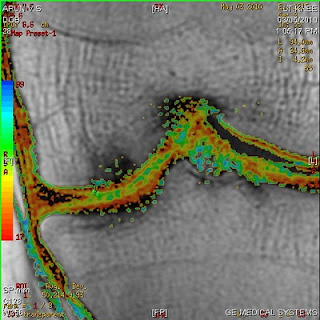A collection of complex joint preservation and replacement case studies and random thoughts of a orthopedic surgeon essentially aimed at knowledge dissemination.
Sunday 29 November 2009
Arthroscopic shoulder stabilisation.
Monday 16 November 2009
Ankylosed knee with patellar fracture - by Sreenath for opinion
 54 yr male with trauma history of ankylosis same knee following septic arthritis at 16 yrs of age,diabetes controlled by dietnot willing for tkr as he had thought about it becos of ankylosis earlier and firm on that decision,no pain previously,office job
54 yr male with trauma history of ankylosis same knee following septic arthritis at 16 yrs of age,diabetes controlled by dietnot willing for tkr as he had thought about it becos of ankylosis earlier and firm on that decision,no pain previously,office job Questions for academic interest
Questions for academic interestOATS

Similar defect in the lateral femoral condyle covered by a bioscaphold( Trufit) in a 40 year old man with equally good short term result-18 months
Friday 13 November 2009
arthroscopic decompression of Spinoglenoid ganglion


25 yr old male, Pain ,weakness -7 months insiduous onset
No history of injury. Conservative treatment for 6 months elsewhere
external rotation weakness (rt) shoulder, Wasting of infraspinatus
MRI Confirms an spinoglenoid ganglion. Options include open excision, ultrasound guided aspiration, arthroscopy to adddress labral lesion and ganglion. We Elected to do an arthroscopic ganglion decompression with immediate relief of pain. Surprisingly no labral tears were found and the ganglion alone was decompressed.

We has since then done another similar case where in a large type 2 b labral tear which was repaired.
Infra spinatus wasting
Options of management include
Spontaneous resolution of the ganglion piatt et al j.of shoulder and elbow surgery,2002 (2 pts )
IMAGE GUIDED ASPIRATION OF THE CYSTS (mixed results)
recurrence common , Tung et al j.of roentgenology 2000 ¾ recurrence in 4 months
Open excision deltoid splitting/detachment
intraarticular pathology undiagnosed
Arthroscopic
Snyder et al ,j.of arthroscopy,2006
Iannotti et al,j.of arthroscopy 1996
chen et al j. of arthroscopy,2003
Type 3 b infected open fracture distal femur and proximal tibia





25 year old male with type 3 b open fracture of distal femur and proximal tibia and lateral facet of patella presented I week after the injury with infected ( wound was contaminated with mud and leaves found 1 week after the injury when the patient presented to us).
Repeated debridement daily under epidural 5 times in 6 days followed primary grafting with iliac crest HAP granules soaked in polymyxcin which was sensitive for gram negative enterocooci and E. coli.
At 6 months with no evidence of infection and the fracture show tricortical bridging. He is mobilised with a single crutch. The range of movement is 0 to 60 degrees with quads tightness.